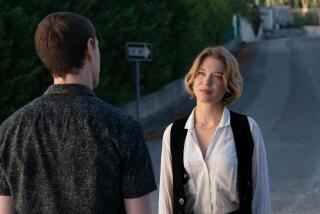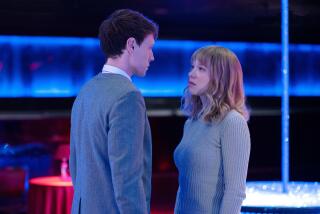‘Eyes Without a Face’ balances lyrical with horror
It’s a classic variation on the eternal triangle: brilliant doctor, innocent subject and the transgressive experimentation that binds and threatens to destroy them. In the case of the elegant creepfest “Eyes Without a Face,” the patient is the doctor’s disfigured daughter, and his single-minded pursuit of a remedy is motivated by guilt as much as by hubris and love.
The lyrical and the gruesome have seldom entwined so seamlessly or with such disturbing power as they do in Georges Franju’s 1960 feature, a tale of mad science and fatherly devotion gone extravagantly wrong. Upon its release in France, critics struggled to reconcile the movie’s straight-up horror with its artistry.
Two years later, it hit stateside theaters in an edited, dubbed version that was named “The Horror Chamber of Dr. Faustus” and placed on a double bill with the even more regrettably titled exploitation flick “The Manster.” That schlock-shock trailer — and the original French one, which emphasizes the film’s psychology and its noir attributes — is among the extras in a new high-definition digital restoration that Criterion Collection released Tuesday on DVD and Blu-ray.
PHOTOS: The politics of horror
Also included is Franju’s first film, the 1949 short “Blood of the Beasts,” a tough-to-watch yet beautifully lensed documentary exploring the grim business within Paris slaughterhouses and the serenity of their surroundings. With its unblinking gaze, it’s a telling piece of work; the director’s fiction films deepened that clinical approach rather than departing from it.
Franju, co-founder of the Cinémathèque Française, had a lifelong passion for the strange-but-true, and he claimed that even as a child he found reality far more amazing than fairy tales. He pointed out the distinction in a 1982 television interview: “The fantastic is created, while the bizarre is revealed.”
What he chooses to reveal in “Eyes” has the hypnotic pull of dread without relying on scare-tactic tricks of the trade. The aesthetic is austere and direct. Eugen Shuftan’s black-and-white cinematography maintains a certain distance from the horror in the story of Dr. Génessier, a man hell-bent on restoring the beauty of his daughter, Christiane. A car accident has destroyed her face, leaving intact only her eyes, if not the feelings they express.
For the screen adaptation of Jean Redon’s novel, Franju cast the accomplished actor Pierre Brasseur, whose dozens of screen credits included Marcel Carné’s masterwork “Children of Paradise,” and the unknown Edith Scob. Italian actress Alida Valli completed the deranged household as Louise, a surrogate mother figure to Christiane, Génessier’s partner-in-crime assistant and the successful recipient of one of his tissue-transplant “heterografts.”
PHOTOS: A-list stars, B-grade horror movies
Christiane’s case proves more challenging for the doctor. It’s more urgent too, given that he was behind the wheel when the accident occurred — which he never mentions even as his awareness of it colors his every gesture and glance. Much remains unspoken in “Eyes,” a film that uses dialogue sparingly and whose soundtrack features the baying of caged dogs and composer Maurice Jarre’s crazed-carousel score. (He would soon score a very different type of tale of obsession, “Lawrence of Arabia.”)
At the center of the story is a “large open wound where a face should be,” as a police inspector describes one of the doctor’s victims. That could also describe the raw emotions just beneath the surface in the Génessier household — the grieving, longing and rage that are evident but never acknowledged.
Scob — who played the chauffeur in last year’s “Holy Motors,” Leos Carax’s fractured love letter to the dreamscape of cinema, complete with a nod to “Eyes Without a Face” — spends most of the movie behind an eerily smooth mask designed to hide Christiane’s wounds. In a remote suburban mansion whose mirrors have been blackened, she floats like a ghost through the rooms, and into the basement with its nefarious surgical doings. Atop the slender stalk of that preternaturally long neck, the impassive mask is an otherworldly flower.
SNEAKS: Movie trailers, full coverage
Franju provides a brief, unforgettable glimpse of what lies beneath, in terms of the physical damage: a soft-focus image that hits hard. And then there’s the five-minute surgical sequence halfway through the movie, which reportedly caused audience members to flee or swoon. In the decades since the film’s initial release, horror films have embraced a far more graphic sensibility, but “Eyes” still has the capacity to haunt.
And echoes of its understated nightmare still reverberate. Though Pedro Almodóvar’s “The Skin I Live In” is based on a different book, the Spanish director’s story of surgical atrocity borrows from “Eyes” for its setup and then cranks it up way past 11. The 2011 film deals more explicitly with sex and gender, yet Franju and Brasseur’s portrait of the patriarch is more penetrating. When we first see Génessier entering his inner sanctum, he moves from darkness into light, a father’s hope conflated with his monstrous mission.
Through the film’s lens, the grotesque is matter-of-fact, and all the more provocative because of it. “I love images that make me dream,” Franju said. “But I don’t like someone dreaming for me.”
More to Read
Only good movies
Get the Indie Focus newsletter, Mark Olsen's weekly guide to the world of cinema.
You may occasionally receive promotional content from the Los Angeles Times.






